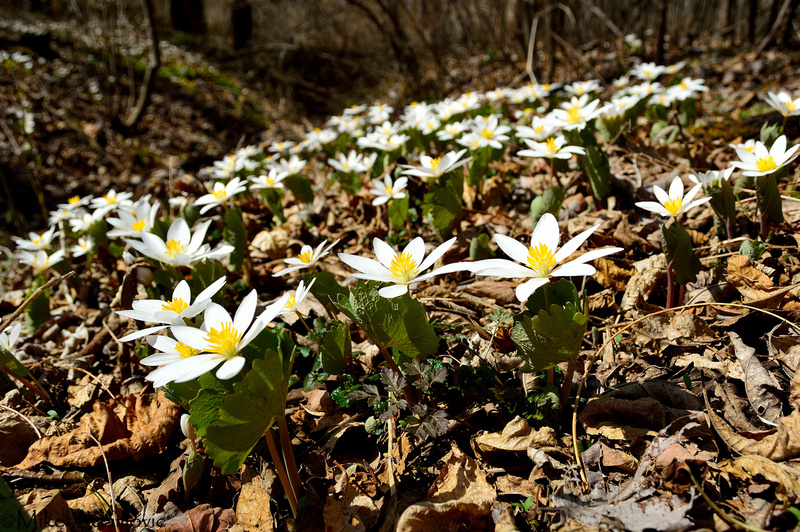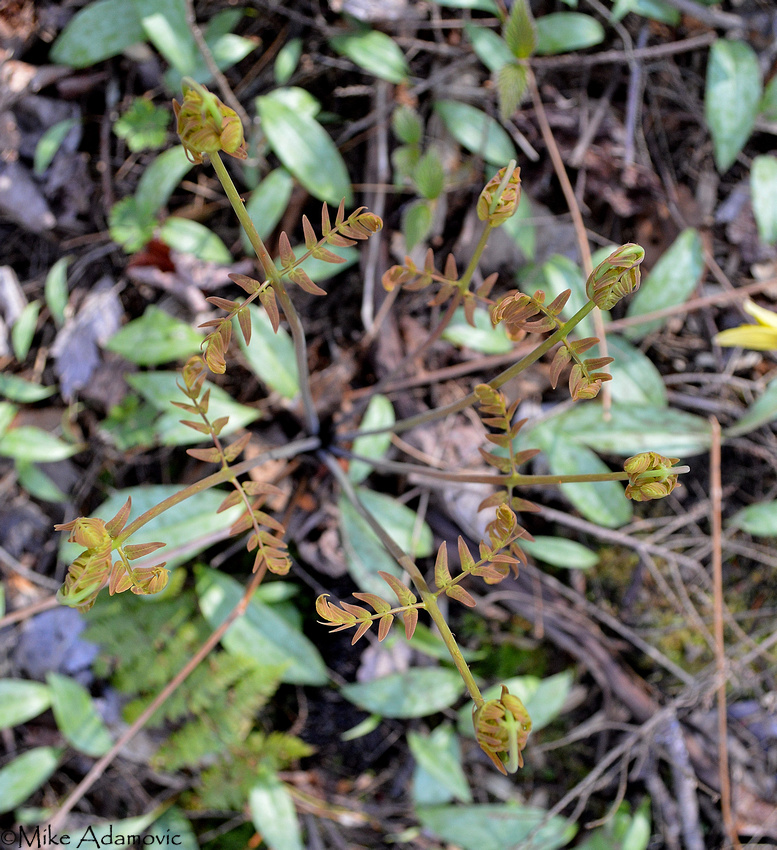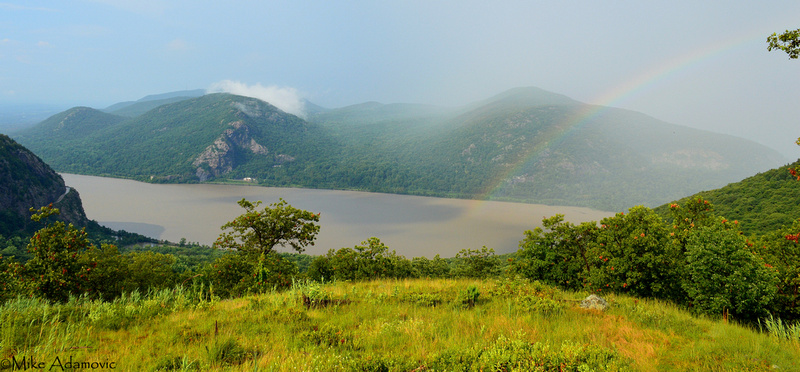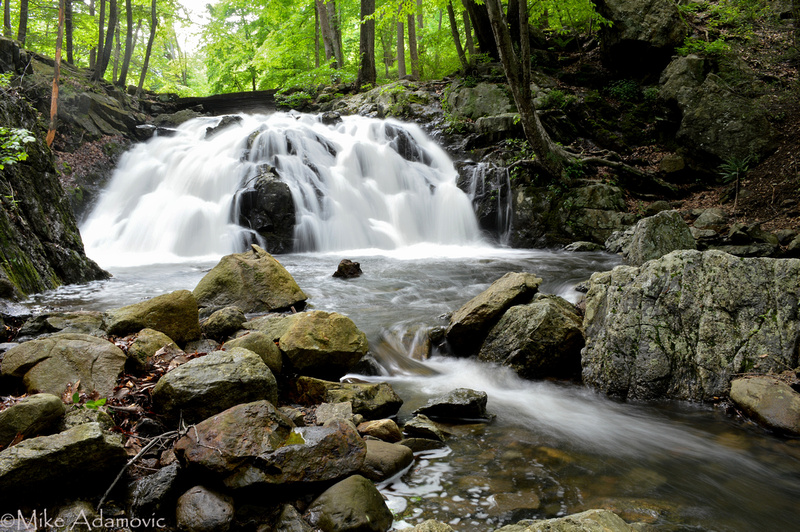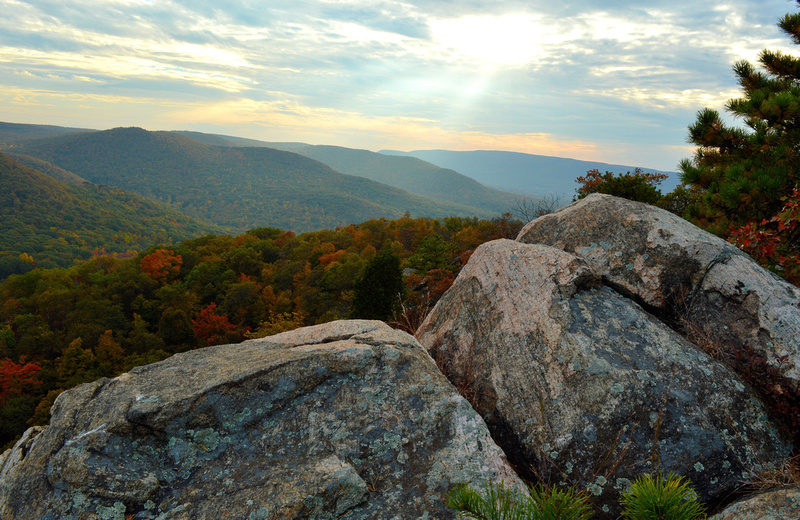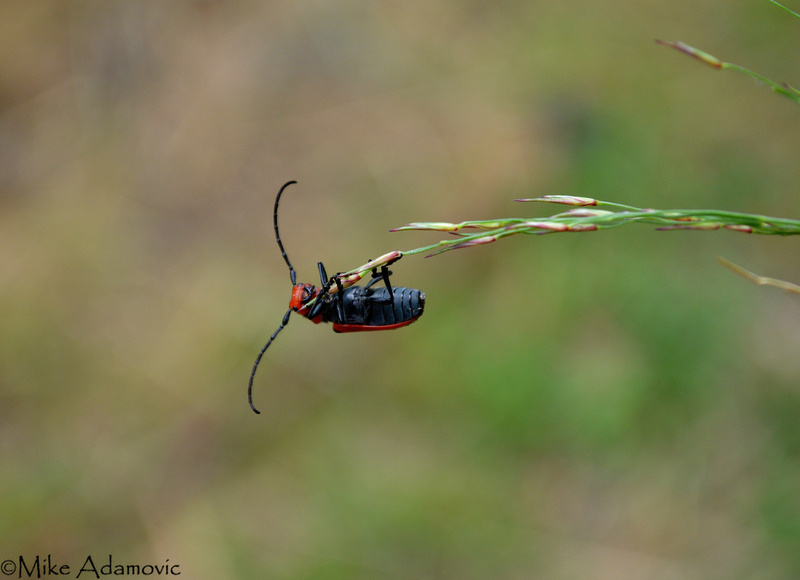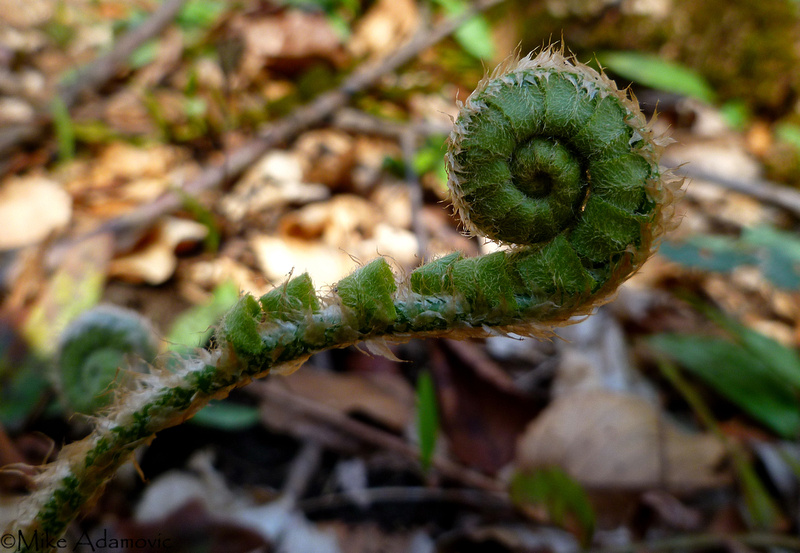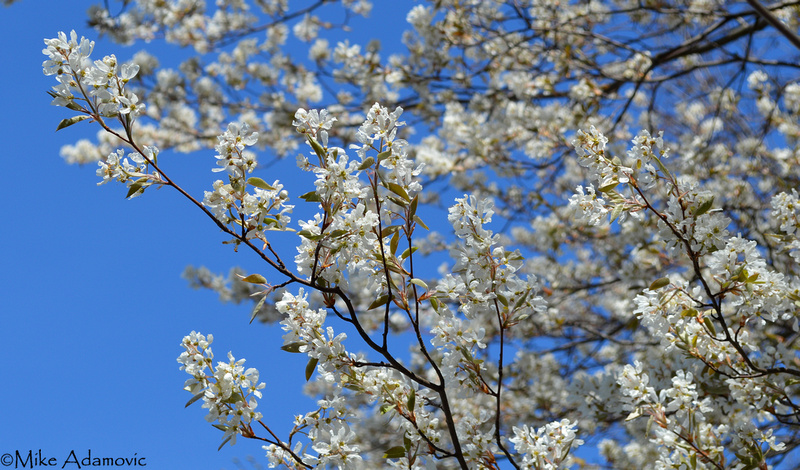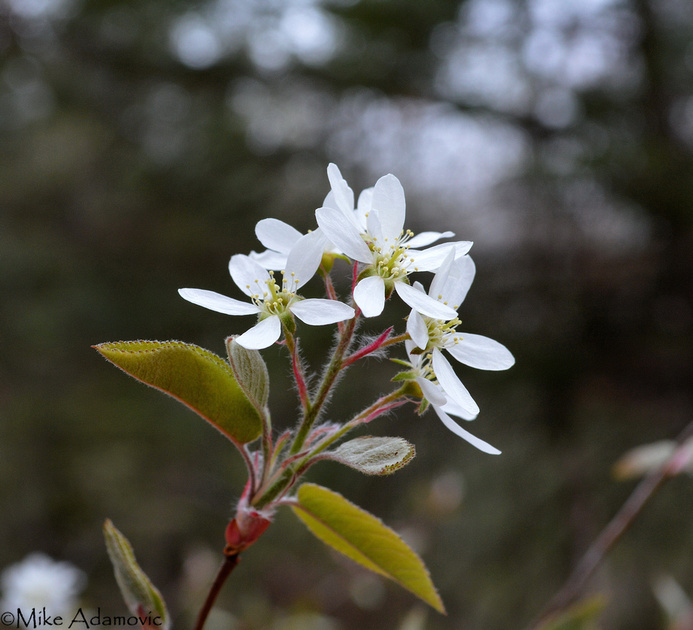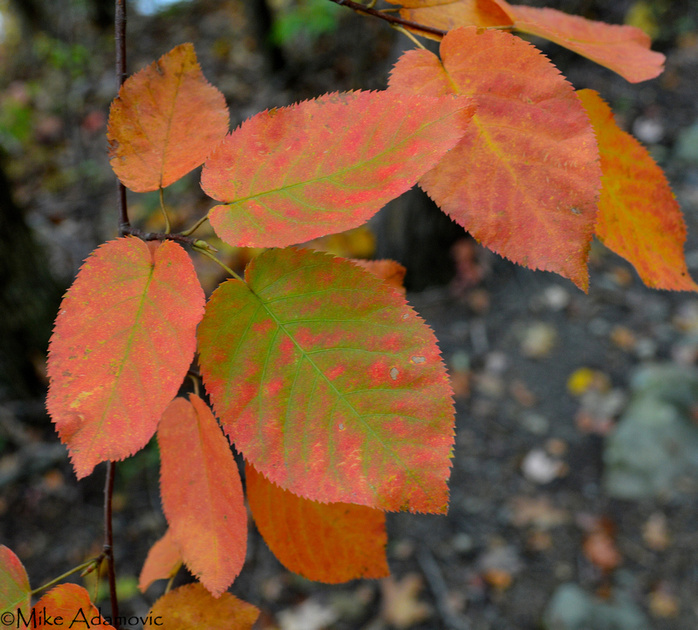Bloodroot (Sanguinaria canadensis)
Quickly after the last of the winter snow has dissipated and a flattened, tawny earth emerges to greet the first rays of the spring sun, certain streamsides and other moist areas throughout our region find themselves covered once more with a dense layer of white. This time the cloak originates from beneath the newly warmed ground, rather than the upper reaches of the chilled atmosphere. Bloodroot, an uncommon spring ephemeral, whose ivory petals surround a bright, golden center, is one of the earliest wildflowers to be awakened by even the most minimal of April heat, eager to bask in the untapped reserve of sunshine now flooding every nook and cranny of the understory. As the name portrays, these plants do indeed possess crimson roots. Moreover, this species bleeds the same as any injured animal. A broken leaf or stem will cause the plant to exude a fluid alarmingly similar to blood. It stains anything it touches, and has been used in years past as a dye by both Native Americans and Colonists. Additionally, root extracts have historically been used to treat a wide variety of ailments ranging from cancer to lung disease to sore throats. And up until recently, it was even employed as an ingredient in Viadent toothpaste to combat gum disease and the build-up of plaque. At the moment, though, the efficacy of bloodroot on anything health related is dubious at best. Numerous sources relate that the root is toxic, and even coming in contact with its juices can cause dermatitis, similarly to poison ivy. It’s hard to believe it was ever consumed—the root’s taste is so acrid that a minor quantity can induce vomiting. Some concoctions were once made more palatable by adding copious quantities of sugar. This is probably one plant that should be appreciated by sight alone. When it comes to habitat, plants prefer moist, rich soils, having an inclination to grow along gently sloping banks. More often than not, they will be found along some type of water body, be it a river, lake, or even a temporary rivulet born of snowmelt. While one of the loveliest flowers of the early spring, it also lives up to the category of wildflowers it’s grouped into exceedingly well (spring ephemerals). Trying to locate an intact specimen requires razor-sharp precision time-wise. With flowers usually lasting no more than a few days, it certainly is imbued with a fleeting nature. Plants will only produce a single blossom, which once lost, will not attain another until the following spring. Typical bloom dates are from mid-April to early May. Like many other spring ephemerals, bloodroot uses ants as a means of seed dispersal, a technique known as myrmecochory. Each tiny seed is equipped with a lipid-rich appendage called an elaiosome. This tempting morsel entices ants to transport the seed back to their nest where they remove the elaiosome and discard the seed body in waste pits that provide an enriched medium for growth. In this way, bloodroot is able to colonize new locales away from the parent plant and ensure optimal germination. Usually found in small groups or clusters, large colonies can develop, containing in excess of several hundred individuals, the result of vegetative propagation, another form of reproduction which produces clones by extension of the rhizomes, or roots.
With bloodroot awakening much sooner than other plants, the large blossoms, as well as the glaucous, almost succulent leaves, create a striking scene among the withered foliage and broken stems of last year’s growth. A particularly large, showy grove is easily spotted at a considerable distance and visually eclipses other ephemeral populations that attain a similar size. There’s something entrancing and fairy-like in the demeanor of these uncommon flowers, with their unique ability to pop up seemingly overnight, transforming the landscape like magic. Such vigor and color contrasts greatly with the bleak debris that surrounds, creating an image of surpassing beauty that’s sure to be emblazoned in memory and sought out year after year.
Amid the briar copses, of sunny vales And moist streamsides; awakened As suddenly upon the beat of quails, A purity surpassing newly fallen snow Richly carpets the earth—a beauty, I thought I’d surely never know.
A lingering moment viewing, Singular works as these, Stops all worthless ruing And fills the heart with ease.
Those cheerful, ivory blooms Whose being is a smile, Sweep away better than a broom, Debris of cluttered forest aisle,
And like the crimson dye That lends the plant its name, It stirs the blood of every passerby And is more worthy of fame— Than ordinary garden denizens. The Return of SpringWinter to many is a foe, an unkind influence, as diabolical as any malevolent entity that can be imagined. We fear and curse it, but stand in awe of its potent capabilities. We avoid it like the plague, if we can, withdrawing and barricading ourselves in our heated, summer-like homes, preparing for the worst. As the tightening, icy winds swirl outside and transform the life-giving ground into iron and drape a stoic cloak over the lighthearted waters of the earth, we pray for salvation from this repetitious pestilence, cloistered away from the sins of the world like a penitent friar or nun. Snow seemingly piled a mile high nearly extinguishes all hope of deliverance. When apathy at last takes hold and begins to invade our very souls the same as frost inches its way through the flesh of the earth, and all appears lost, the stifling clouds miraculously dissolve, letting the heavenly rays descend to squash the cold and harsh monotony of the bleak winter season. Spring has finally arrived—and a myriad trickling streams now hurry the free-flowing blood of the earth back to where it can give new life and reanimate the weary world.
People throughout all ages and cultures not residing in the ever-balmy tropics have been of a similar vein of mind when it comes wishing the woes of winter away and rejoicing at the prospects that blow in with the warming winds. It is therefore not surprising in the least, that spring, the season of rebirth and new beginnings, has been disproportionately memorialized in legend and lore by innumerable cultures. Like most mythology, the most well-known tale comes from Greece: The ancient Greeks believed the changes of the seasons were brought about by the moods of Demeter, the goddess of grain and growth. As legend has it, long ago, autumn and winter were non-existent, and the world was blessed with perpetual summer. This abruptly changed when Demeter’s attractive daughter, Persephone, was abducted by Hades, the god-king of the underworld, who had long admired her from afar, and now wished to make her his bride. The disappearance of Persephone did not sit well with Demeter, who like any good mother, strove to locate her missing daughter. She literally searched both heaven and earth for an answer; and in the process, neglected her godly duties of tending to the world. Crops failed, vegetation withered, and a cold snap the likes of which hasn’t been witnessed since overtook the earth. Scores of people starved or froze to death. Eventually, Zeus, the king of the gods, could no longer countenance the destruction levied upon his dominion. He begrudgingly revealed to Demeter what had taken place (he actually played a role in the abduction), telling her he would instruct his brother Hades to release Persephone from the underworld. Hades agreed to the return, knowing a refusal would bring upon him the full and uninhibited wrath of the almighty Zeus, a mercurial god who was not to be disobeyed. Before doing so, however, he gave Persephone some pomegranate seeds to eat, well knowing this tiny acceptance of food would bind her to him and she would eventually be compelled to come back. Demeter, overjoyed with the reunion, once again smiled. Warmth and fecundity returned to the desolate landscape, resulting in the first spring.
The situation was bittersweet. As the two caught up, recounting the trials each had experienced over the preceding months, Demeter was distraught when she heard mention of the pomegranate seeds her daughter had consumed. It was then realized that things would never again be the same. Zeus decreed that by accepting food from Hades, and thus having had her lips stained by the ruby fruit of the pomegranate, Persephone had blemished herself—a stipulation for her return to earth was to be as pure as the day she had left, a condition she had clearly violated. Knowing that the world would be imperiled if Persephone was forced to always remain sequestered in the underworld, a compromise was struck by Zeus. For half the year Persephone was to spend her time with Demeter, while the other six months of the year she would remain with Hades, reigning as Queen of the Underworld. When Demeter smiles, having the company of her beloved daughter by her side the world rejoices, surrounded by the lush, verdant grandeur of summer. But when she mourns the loss of Persephone to Hades, and is heavy with grief, winter again sweeps across the earth.
Thoreau's "Tonic of Wildness"
Nature today is an element which we find ourselves as a society increasingly thirsting for as our lives become more disconnected and removed from the environment. It’s no coincidence that in the last several decades the environmental movement, hiking, backpacking, “going green,” and other similar activities and trends have proliferated. When we extricate ourselves from the natural world we begin to wither and degrade in the same manner as if we were suffering from a tangible vitamin deficiency or ailment. To ameliorate this, as Henry David Thoreau noted, “We need the tonic of wildness;” that it’s necessary from time to time to escape into nature and “wade sometimes in the marshes where the bittern and meadow-hen lurk… to smell the whispering sedge where only some wilder and more solitary foul builds her nest, and the mink crawls with its belly close to the ground.” Essentially, for this rejuvenating tonic to be effective one must completely surround and immerse themselves in the wild and untamed influences of nature. Thoreau found that everlasting vigor and contentment was not to come from the amalgamation of noxious compounds forged together in a dank and congested lab, like the folly quest of an alchemist in search of some magical elixir, but that a real fountain of youth, a naturally occurring panacea, already exists and can be extracted from the earth as easily as an inhalation of breath into the lungs—taking a walk outside and imbibing in the fresh air and surrounding beauty is all that’s required. Such a simple discovery—yet one commonly overlooked by most who happen to believe happiness, health, and wealth can only come about by human innovation. He freely shared his keen insights, hoping to better a world he saw as following a “descending and darkening” path. “Our vision does not penetrate the surface of things,” Thoreau records in Walden, pithily adding, “We think that that is which appears to be.” This is a man who possessed a remarkable power of observation and was able to look at even the seemingly most mundane of objects or situations and take away a grand or universal message. As he aptly put it, “The question is not what you look at, but what you see.” Reading his deeply insightful revelations today, many appear to be common sense logic—that anyone should be able to take away the same messages from viewing these things, yet few would be able to come upon the same conclusions before first becoming acquainted with Thoreau’s passages. It’s startling how superficial our outlook can be sometimes. “While almost all men feel an attraction drawing them to Society, few are attracted strongly to Nature. In their relation to Nature men appear to me for the most part, notwithstanding their arts, lower than the animals. It is not often a beautiful relation, as in the case of the animals. How little appreciation of the beauty of the landscape there is among us! We have to be told that the Greeks called the world Kosmos, Beauty — or Order, but we do not see clearly why they did so, and we esteem it at best only a curious philological fact.”
Thoreau enjoyed discussing perception and drilling straight through things thought to be of adamantine strength, upending centuries or millennia of tradition with a simple sentence. He demonstrated that it’s necessary to constantly reposition ourselves to a new angle, allowing us to gain a clear line of sight into crevices which had once been obscured by our peripheral glances. In his essay, Walking, Thoreau extols the virtues and benefits of sauntering outside on a regular basis, comparing a stroll through nature as a pilgrimage through the “Holy Land.” He didn’t see walking as a purely recreational hobby or a way to stay in shape, but viewed it as a vector to the divine. “The walking of which I speak has nothing in it akin to taking exercise,” he casually warns. The diversity, richness, and beauty of the outdoors always offers up something new and exciting to those who take the time to view the works of nature. No matter how long an individual devotes to seeking out its mysteries there are always more to uncover. It’s something that can never be exhausted or lead to a dull monotony. You can focus on the landscape as a whole, or you can zoom into individual parts, which are no less detailed than the largest objects. “Nature is full of genius, full of divinity, so that not a snowflake escapes its fashioning hand.”
The other main reason Thoreau enjoyed rambling into the depths of primitive forests and summiting lonely peaks with majestic vistas was to withdraw from a society that stifled and frustrated him. “I love Nature,” Thoreau records in his journal, “partly because she is not man, but a retreat from him. None of his institutions control or pervade her… He is constraint, she is freedom to me. He makes me wish for another world. She makes me content with this.” In the woods he was buffered from prying eyes and would forget his “obligations to society.” Here he could unwind in a manner agreeable to himself. Many of us today can relate. Who after a foray into the woods hasn’t felt reinvigorated after the tension and accumulated stress of daily life gradually diminishes and fades away almost altogether? Additionally, nature or “wildness,” as Thoreau was apt to describe it, is the spring-source of “absolute Freedom.” It offers up a fecund bounty free for the taking, whether of intangible experiences and opportunities or supplying all the “necessaries of life.” It doesn’t charge exorbitant entrance fees or monthly rent—rather, all who perambulate and harbor an earnest appreciation of the surroundings are entitled to a portion of its vast wealth. It doesn’t know of, nor respects, any imaginary boundary lines. An individual has free range of this “widespread garden” and can travel as far, or climb as high, as his own limits will allow. There are no laws to obey other than those of the universe. An intimate relation to the bare and primitive elements, to those “forces not bound to be kind to man,” raw and uninhibited matter at its finest, removes all trivialness from the equation. We can see things as they truly are. Vain aspirations and undue pride evaporate as quickly as evening dew in front of the expanding morning sun. Facing such sublimity and wonder we “stand in awe,” and as Thoreau admittedly voiced, “I would fain return to my senses.” Amid a grove of gnarled soughing pines, jumbled heaps of stone, and stinging mountain air, we momentarily lose ourselves and observe that only the simple necessities have any true worth and permanent value.
A trip in the summer of 1846 to the craggy and windswept summit of Mt. Katahdin, a dizzyingly remote and lofty peak in Maine, provided Thoreau with a revelation exceedingly more profound than what he was normally dealt on his daily walks. Similarly to Moses who ascended Mt. Sinai and was bequeathed the Ten Commandments, Thoreau was also ordained a divine message that he would share with the world, one that reinforced and solidified what he already felt to be true about the necessity of pure, undiluted nature. He found Katahdin “a specimen of what God saw fit to make this world,” rhapsodically continuing: “What is it to be admitted to a museum, to see a myriad of particular things, compared with being shown some star's surface, some hard matter in its home! I stand in awe of my body, this matter to which I am bound has become so strange to me. I fear not spirits, ghosts, of which I am one, — that my body might, — but I fear bodies, I tremble to meet them. What is this Titan that has possession of me? Talk of mysteries! — Think of our life in nature, — daily to be shown matter, to come in contact with it, — rocks, trees, wind on our cheeks! The solid earth! the actual world! the common sense! Contact! Contact! Who are we? where are we?” Nature can be singularly congenial or it can be decidedly harsh, yet nevertheless, it always imparts a sense of wonder and divinity that can’t be located on such an encompassing level elsewhere, even in our most sanctimonious chapels and cathedrals. As Thoreau prophetically discovered, if you would converse or commune with God, it must be done face to face, in the open air. “Heaven is under our feet and as well as over our heads.” Thoreau wished to take as much out of life, and live as close to the bone, as was humanly possible. When life’s conclusion approached he didn’t want to be among the discontented multitude that possessed heavy regrets and looked back to see that life had not been lived to the fullest. Instead, he aspired to “live so sturdily and Spartan-like as to put to rout all that was not life.” In the forests and the fields and anywhere else where nature resided, he journeyed to in order glimpse those eternal mysteries that imbue men with perennial youth. He has provided perhaps the most implicit and succinct reason coined to date that sums up of the pursuit of the wild—“I went to the woods because I wished to live deliberately.” It’s as simple as that.
O Nature! I do not aspire ~Henry David Thoreau
The Blooming of the Shadbush
After the cold of winter has subsided and the earth has had a chance to slowly warm for several weeks, shadbush, also known as serviceberry, illuminates the grayness of the torpid and bleak forests of the region by producing an explosive array of cream-white flowers in late April. While some of the notable spring ephemeral wildflowers nestled among the shifting leaves and detritus of forest floor make an earlier appearance, they may not be noticed until practically stepped on. In contrast, this tree which rises in height to 10-25 feet is sure to be seen, even at a considerable distance. Its billowing puffy floral clusters draw the eye the same as a lone cloud piercing the azure monotony of the sky. Shadbush is so-called by the use it served to Native Americans. The highly visible and well distributed tree served as an important temporal marker. Its blooming coincides with the yearly spring arrival of shad in regional estuaries. These fish were a vital staple to the Indians’ diet, having consumed most of their winter food reserves by the time of shad’s return. The resilient wood was also supposedly used for making arrow shafts. Serviceberry, another popular name, has a more depressing derivation. The bloom date of the tree indicated to settlers of New England that the ground was sufficiently thawed to allow for grave digging to commence for the deceased who had passed during the winter, whereby burial “services” could finally be conducted.
A month after the trees have produced the last flowers, a tasty and handsome fruit not unlike the blueberries which can often be found sprouting copiously from the understory beneath in many cases, appear in dense, drooping clusters. Berries tend to ripen toward the end of June, giving way to yet another name, Juneberry. Thoreau was rather fond of collecting the rather obscure fruit, and pronounced “them a delicious berry, nearly equal to blueberries and huckleberries,” further adding, “they are perhaps the sweetest bush berry, and they need only to be more abundant to be generally appreciated.” Many local Indian tribes utilized the berries in a variety of ways. Apart from drying and storing them for winter use, fresh berries would be crushed and added with nuts, fat, and meat to create an energy and protein rich pemmican. There are a number of medicinal uses recorded as well, ranging from ameliorating liver ailments to treating constipation. Several different shadbush species are native to the Northeast, garnering such names as downy, mountain, and lovely shadbush, among numerous others. Many varieties are quite similar, and have a propensity to interbreed when clumped together. The tendency for hybrid versions to emerge oftentimes makes a concrete identification difficult, stumping even the most astute botanist. For the casual observer who has little interest in delving into taxonomic complexities, the generic “shadbush” suffices. In October, the tree once more becomes breathtakingly beautiful, though a glance this time may bring about feelings more reflective than jubilant. Instead of its showy blossoms forecasting countless warm, sunny days ahead, filled with a promise of a myriad of multi-hued wildflowers and summer verdure, inflamed autumnal leaves rather portend a dip in seasonal fortune, marked by pressing cold and uniformity. The fiery appearance of the shadbush, which directly echoes a bonfire in both color and visual intensity, encourages the viewer to prepare and stock up on fuel for the coming winter.
Though shadbush is a pretty tree to admire while among the woods, its reverence has come about more by the utilitarian use it serves. Whether informing of the arrival of shad, or the proper time to begin burial services, or simply providing a sweet treat or durable wood, this tree is always there to lend a hand. With this in mind, it’s easy to see why it has been held in such high esteem since the early days of humanity. Vernal Migration: Ephemeral PoolsIn mid to late March, or in the case of a severe winter, early April, the first signs of spring can be witnessed stirring in shallow woodland pools filled with amphibians, reptiles, and even freshwater shrimp. These creatures appear at least a couple weeks prior to the wildflowers that we often view as the harbingers of spring. Usually we will know the season has arrived by sound, rather than sight. After the first warm rain, amphibians roused from their hibernation in the mud and detritus of the forest floor gather together in copious quantities in temporary ponds that have appeared with the addition of meltwater from winter snow and ice. The small ponds, usually not larger than a backyard swimming pool, go by many names, such as vernal, woodland, or ephemeral pools, generally with the latter being most appropriate. Within the basins a sonorous and usually deafening hymn can be heard going round the clock for several weeks. A walk in the quiet solitude of a gray-brown forest is often quickly interrupted upon approach of one of these pools, quickening the pulse, and giving proof that the landscape is in the process of being rebooted, just as our sluggish minds and bodies are after being confined these past long, cold months. Without a doubt, the first, and most prolific life to be found, is the wood frog. This species has a wide distribution in the U.S., occupying most of the east coast north of Georgia and continuing westward to Minnesota. Frogs also inhabit a majority of Canada and Alaska. On a cold day just before a warming rain, these pools are empty, aside from the innumerable leaves and branches lining the bottom, and are nothing extraordinary to behold. After the water begins to penetrate the leaf litter and sink into the ground, the frogs burst from their hiding places in unison during the night if the ambient temperature spikes to at least 40° F. They appear in the thousands or millions in a rain swept area. Drivers will have to be mindful of the roads during these times as the frogs recklessly journey across the pavement in migration to their watery mating grounds, often those in which they themselves were born. The following day a return visit to the pools morphs into a lively spectacle, complete with a cacophony of sound that resembles a mix begin the quacking of a flock of ducks and the buzzing of a bee hive—the mating call produced by males.
Wood Frogs Wood frogs are able to make a speedy exit from the confines of their winter hibernacula. Rarely do they burrow into the earth more than a few inches. They frequently lie just below the leaf litter in a zone that offers protection from the physical elements, such as snow, harsh winter winds, and predators, but doesn’t quite ensure adequate insulation from the penetrating cold. The frigid weather that would easily kill most amphibian species doesn’t seem to bother the wood frogs—their bodies are actually capable of freezing solid during the winter and thawing out in the spring, the result of special proteins that keep cells from being damaged by ice crystals. At a short distance from the pools the deafening calls drown out all other forest sounds; but upon reaching the borders the noise instantly ceases giving way to an uneasy silence, only interrupted periodically by the occasional splash from individuals too closely approached. In some of the larger ephemeral pools it may be difficult to spot the wood frogs, with most blending into the inky waters; some females being the exception, cloaked instead in a ruddy pink. A thorough scan of the water may reveal a male statically floating atop the water, with all appendages spread out, similarly to one pinned to a dissection board. Their eyes are tightly fixed on your position for the duration of your stay. Only those males who have a locked onto a female and are in competition for the privilege to mate seem to be too enraptured on their goal to pay any notice to a nosy human. Some splashing might attract your attention, where a bloated female being harassed by multiple males is spotted, all trying desperately to attach themselves to her body—it’s not uncommon to see 4 or 5 in pursuit of the same female. In the process of them trying to clasp themselves to her, the flailing of their legs propels the lot around the pond, as if a motorized boat. In such cases, it’s quite easy to walk up to them without the frogs scrambling away, and, if you so choose, pluck one from the water. In this state mating becomes more important than endeavoring to avoid predators.
Wood Frogs in Amplexus Each female lays about 1,000 eggs, all congealed into one solid jelly-like mass that is usually attached to some sort of aquatic vegetation or detritus. The black dots seen within the cluster are individual eggs, which, within a month, will hatch and morph into tadpoles. Egg masses are rarely solitary; normally all females of the pond group them together in only one or two areas, forming vast clusters, or aggregates that can be quite thick, reaching from the bottom of the pool to the surface. As the weather warms, algal blooms within the ephemeral pool usually coat the eggs, making the floating mats resemble pond scum. This is a rudimentary cloaking device that keeps the eggs hidden from sight, and ensures the slimy, green masses remain an unsavory meal choice for any animal that can peer through the deception.
Wood Frog Egg Masses If all goes well and the pools remain filled with water, within two months the diminutive tadpoles will fully transform into terrestrial adults. Once mature, they will exit their natal ponds and join their parents in the forest until the following spring, when the end of winter rains gently nudge them out of their hiding places and encourage the frogs to take part in the cyclical vernal migration. Wood frogs may be the most visible species to utilize ephemeral pools, but they are far from the only ones that rely on them for breeding. Numerous salamander and newt species, decked out with vibrant colors and abstract mottling also journey to these places to mate. Spotted, blue-spotted, tiger, marbled, and redback salamanders, with their aptly descriptive names, can be found in these localized pools for a brief duration. The red-spotted newts, the plebian dwellers of these environs, are usually the only amphibian species aside from the frogs that are somewhat easily viewed. Most of their salamander cousins are rather elusive and are rarely seen, with their eggs being the only trace giving hint of their presence. Each species’ egg mass differs in shape, coloration, and number of eggs contained within. Identifying species by egg clusters alone is normally how biologists are able determine the amount of biodiversity within a given area.
Red-spotted Newt Along with frogs and salamanders, the occasional turtle can be seen roaming about the pools before they dry up; various aquatic insects plying the surface and some traversing the depths swarm throughout; and the fairy shrimp, a crustacean similar to “sea-monkeys” (brine shrimp) know of no other home. In short, these pools though small and transient occupy a significant niche in the landscape. The size of these water bodies, however, often leads to their demise. Individuals who lack a knowledge of the importance of ephemeral pools too often view them as nothing more than mosquito breeding grounds. They fail to get close enough to them in body and mindset to witness the beauty and biologically rich array of life within, and thus, frequently set out to rid their property of these bits of so-called swampland. Unless unusually significant in some way, most pools garner no legal protection, being well under the required wetland size of 12.4 acres (5 hectares) to qualify for protective status in New York. Ephemeral pools, as their name suggests, may be just that—ephemeral—as they are quickly vanishing from our forests, a result of continued sprawl and apathetic attitudes towards the environment.
Spotted Salamander |


